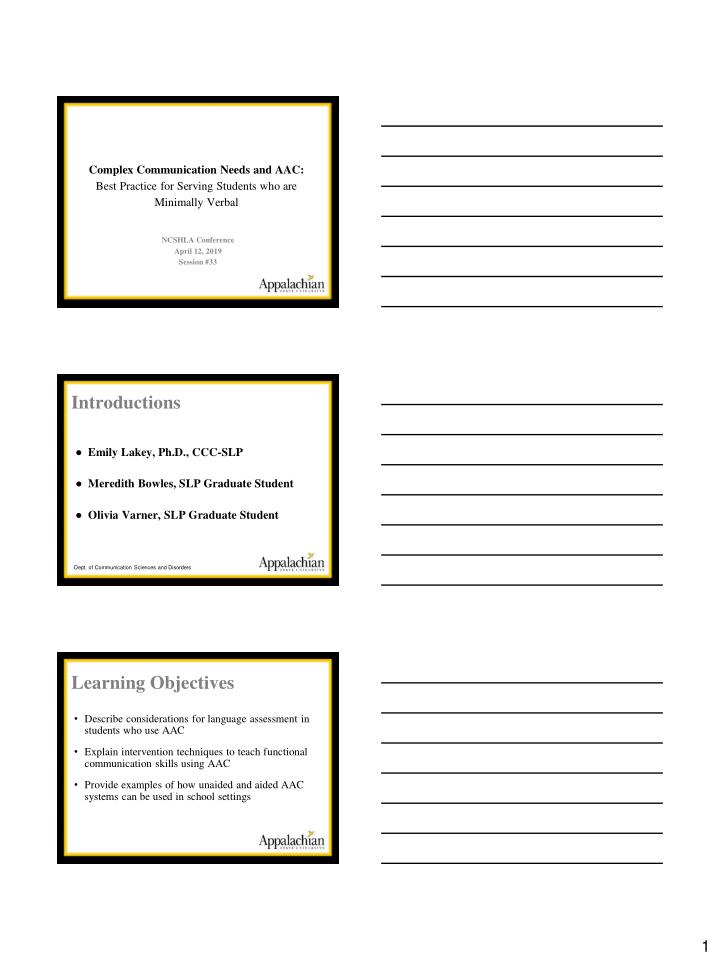



Complex Communication Needs and AAC: Best Practice for Serving Students who are Minimally Verbal NCSHLA Conference April 12, 2019 Session #33 Introductions ● Emily Lakey, Ph.D., CCC-SLP ● Meredith Bowles, SLP Graduate Student ● Olivia Varner, SLP Graduate Student Dept. of Communication Sciences and Disorders Learning Objectives • Describe considerations for language assessment in students who use AAC • Explain intervention techniques to teach functional communication skills using AAC • Provide examples of how unaided and aided AAC systems can be used in school settings 1
Session Agenda ● AAC Myths ● Practical strategies for AAC assessment ● Practical strategies for AAC intervention Augmentative and Alternative Communication (AAC) Communication systems, methods, strategies and tools that replace or supplement natural speech ● Augmentative ● Unaided ● Alternative ● Aided Myth #1 AAC should be introduced only after it has been determined that a child cannot use natural speech 2
Myth #2 High-tech AAC is always the goal What’s the purpose? The most effective interactive communication possible https://www.asha.org/public/speech/disorders/CommunicationDecisions/ SNUG Spontaneous Presuming Novel competence Utterance Generation 3
Myth #3 AAC is not appropriate for children with severe cognitive impairment Myth #4 AAC is not appropriate for children with severe motor impairment If a child can’t use his/her hands to touch the device/pictures... ● Eye tracking ● Using another part of the body 4
AAC Assessment • Who are likely candidates for AAC? • What should be assessed? • When should you use high tech or low tech? (What is the best “tool”?) • Where should an assessment take place? • Why should a student be assessed for AAC? AAC Assessment World Health Organization’s International Classification of Functioning, Disability and Health (ICF) framework (ASHA, 2016; WHO, 2014) ● Impairments in body structure and function ● Effects on activities and participation ● Contextual factors: barriers or facilitators Comprehensive Assessment for AAC ● Case history ● Ecological inventory ● Self-report ● Sensory and motor status ● Spoken language assessment ● Written language assessment ● Social communication assessment ● Cognitive communication assessment ● Symbol assessment ● Feature-matching assessment ● Identification of contextual facilitators and barriers 5
Sample AAC Assessment Tools ● Augmentative & Alternative Communication Profile (AACP): A Continuum of Learning ● Communication Matrix ● Functional Communication Profile Revised (FCP-R) ● Student-Environment-Task-Tools (SETT) Framework ● Test of Aided-Communication Symbol Performance (TASP) ● Wisconsin Assistive Technology Initiative (WATI) Assessment → Intervention ● Meaningful Contexts for Communication ● Effective means to Communicate (mode, “access”) ● Appropriate Vocabulary ● Environment Supports Communication ● Appropriate Interaction Strategies 6
Effective Communication occurs when the intent and meaning of one individual is understood by another person Vocabulary Words, short phrases, sound effects Watch and listen • What does the child need/want to communicate? • Opportunities to connect and be playful? Watch and listen to other children in the environment Talk to communication partners Review vocabulary lists or questionnaires CORE Vocabulary Light & Drager, 2012 Core Vocabulary High-frequency, multi-purpose, commonly occurring words from a range of word classes that are a central part of an individual's AAC system http://www.project-core.com/core-communication-systems/ 7
Intervention Approaches to Teach and Support Communication Using AAC ● Environmental Arrangement ● Embedded Opportunities ● Modeling ● Prompting ● Responsive Interaction Environmental Arrangement ● Manipulating aspects of the physical environment to promote communication Embedded Opportunities Intentional, systematic opportunities for meaningful communication and participation in a variety of everyday activities and routines Blocked response/interrupted behavior chain • Expectant delay/time delay • Contrastive examples • 8
Modeling ● Aided language input ● Focused language stimulation Prompting ● Scaffolding levels of support ○ Most-to-least ○ Least-to-most ● Independence Prompting: Start with Errorless Learning 9
Least-to-Most Prompting Responsive Interaction ● Respond to attempts to communicate ● Recasts/expansions How do we know it’s working? Functional…. Communication …. SNUG Progress monitoring 10
COMMUNICATION BILL OF RIGHTS The right to interact socially, maintain social closeness, and 1. build relationships The right to request desired objects, actions, events, and 2. people The right to refuse or reject undesired objects, actions, events, 3. or choices The right to express personal preferences and feelings 4. The right to make choices from meaningful alternatives 5. The right to make comments and share opinions 6. The right to ask for and give information, including 7. information about changes in routine and environment The right to be informed about people and events in one’s life 8. Brady et. al (2016). Communication services and supports for individuals with severe disabilities: Guidance for assessment and intervention. American Journal on Intellectual and Developmental Disabilities, 121(2), 121-138. COMMUNICATION BILL OF RIGHTS 9. The right to access interventions and supports that improve communication 10. The right to have communication acts acknowledged and responded to even when the desired outcome cannot be realized 11. The right to have access to functioning AAC (augmentative and alternative communication) and other AT (assistive technology) services and devices at all times 12. The right to access environmental contexts, interactions, and opportunities that promote participation as full communication partners with other people, including peers 13. The right to be treated with dignity and addressed with respect and courtesy 14. The right to be addressed directly and not be spoken for or talked about in the third person while present 15. The right to have clear, meaningful, and culturally and linguistically appropriate communications Brady et. al (2016). Communication services and supports for individuals with severe disabilities: Guidance for assessment and intervention. American Journal on Intellectual and Developmental Disabilities, 121(2), 121-138. Resources North Carolina Augmentative Communication Association (NCACA): https://ncaca.info/ North Carolina Assistive Technology Program: https://www.ncdhhs.gov/divisions/vocational-rehabilitation-services/north-carolina- assistive-technology-program Exceptional Children's Assistance Center (ECAC) https://www.ecac- parentcenter.org/ AAC Institute: https://aacinstitute.org/ International Society for Augmentative and Alternative Communication (ISAAC): https://www.isaac-online.org Rehabilitation Engineering and Assistive Technology Society of North America ( RESNA): https://www.resna.org PrAACtical AAC: https://praacticalaac.org/ A.T.TIPSCAST : https://attipscast.com 11
Questions? Thank you! Email: lakeyer@appstate.edu 12
Recommend
More recommend